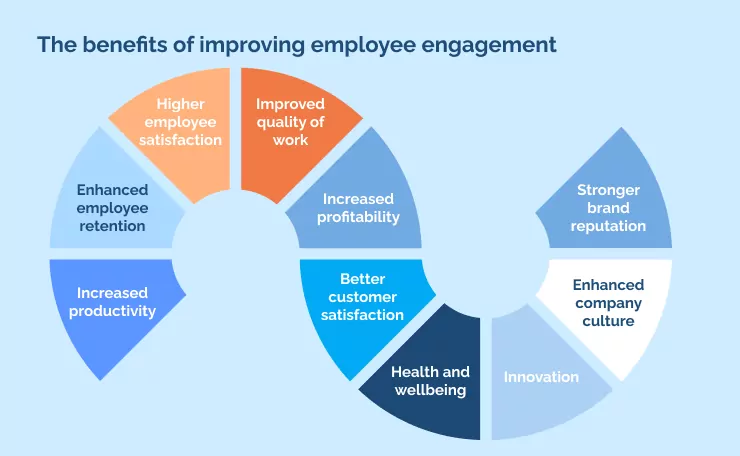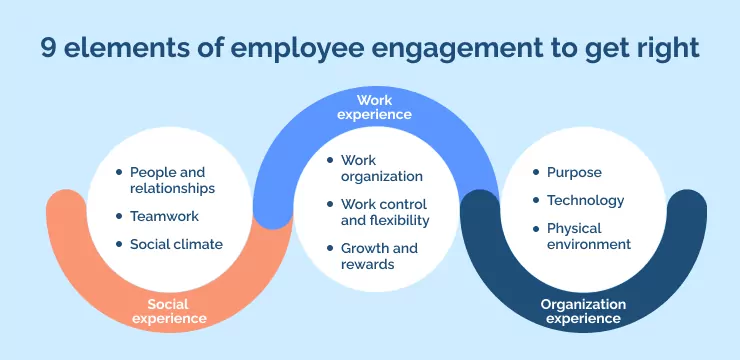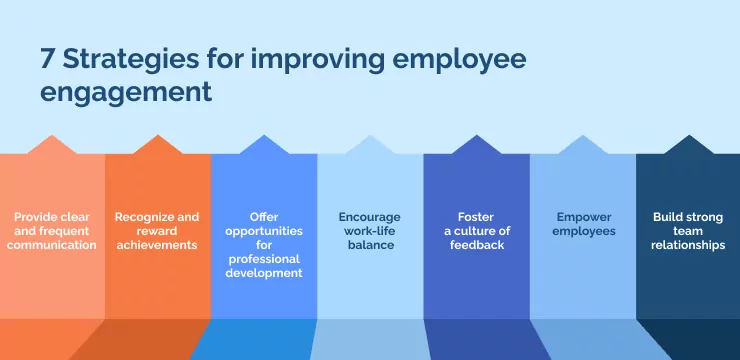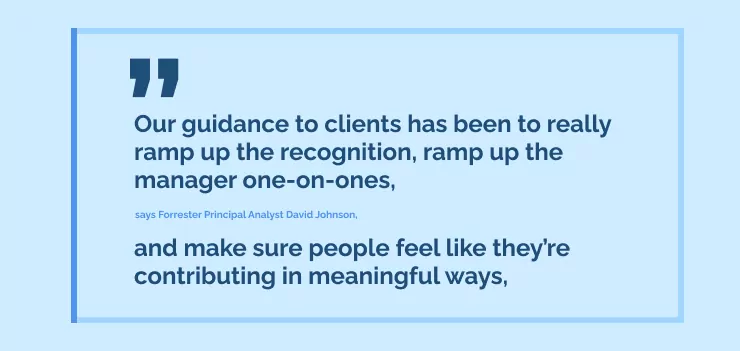
Employee engagement measures how enthusiastic and committed your employees are to their jobs. Highly engaged employees care about their work, feel like they’re making a difference, and take an active interest in the development of your business.
Improving employee engagement is no easy feat, but having an engaged workforce makes change management much easier. Not to mention the countless other benefits.
In this article, we will cover the fundamentals of employee engagement. You’ll learn:
- What is employee engagement?
- Why is it so important?
- How do you drive employee engagement up?
We’re explaining everything from leading theories on employee engagement to practical strategies you can use to get started today.
The basics of employee engagement
Employee engagement is a measure.
To boost employee engagement, you need to focus on improving the employee experience.
It’s important to understand the interplay between these two terms. There’s usually a direct correlation: Invest in improving the employee experience, and you’ll see a boost in employee engagement.
According to research from Mckinsey in 2021, companies that are leaders in employee experience see a 40% increase in discretionary effort from their employees.
This basic premise should underpin all of your efforts to increase employee engagement.
If you want employees to go the extra mile, you must provide a world-class employee experience.
The mistake most businesses make when it comes to employee engagement
Many businesses see the employer-employee relationship as, well, a business transaction.
“I pay you a salary, and you are an engaged, productive employee.”
Don’t fall into this antiquated line of reasoning. The reality of our modern age is that the salary you pay an employee probably isn’t enough to make them care about their work.
And you can’t just buy your employees off, either. A Mckinsey survey found that 55% of employee engagement is driven by non-financial factors.
To boost employee engagement, you need to focus on creating an engaging, challenging, balanced work environment.
You need to give employees the space to grow and the freedom to learn.
Employee engagement is a problem that money alone can’t solve. Luckily, there are strategies you can follow to help you achieve a high level of engagement.
The benefits of improving employee engagement

Before you can justify any initiative to increase employee engagement, you might need to create a robust business case to present to leadership.
This list of 10 benefits of improving employee engagement is a great place to start:
- Increased productivity
Engaged employees are often more productive.
They are motivated, take ownership of their work, and are likelier to go above and beyond to meet your company’s goals.
- Enhanced employee retention
Employees who feel engaged are likelier to stay with your company, reducing turnover rates and related costs.
They feel valued and have a stronger emotional connection to your company.
- Higher employee satisfaction
Engaged employees are typically more satisfied in their roles, leading to increased morale and overall job satisfaction throughout the company.
- Improved quality of work
Employees who are engaged are more likely to care about their work, which can lead to higher-quality outputs and fewer mistakes.
- Increased profitability
Engaged employees can lead to better business outcomes.
Companies with high levels of employee engagement are more profitable.
- Better customer satisfaction
Engaged employees are often more customer-oriented.
They’re more likely to provide high-quality service, increasing customer satisfaction and loyalty.
- Health and wellbeing
Engaged employees tend to report better health and well-being.
They’re often more resilient, less prone to stress and burnout, and can bring positive energy to the workplace.
- Innovation
Engaged employees are more likely to be committed to the organization’s success, leading them to contribute more ideas and innovative solutions.
- Enhanced company culture
High levels of engagement can help create a positive company culture where employees feel connected to one another and the company’s mission.
- Stronger brand reputation
Companies with engaged employees often have stronger reputations, making attracting top talent and customers easier.
9 elements of employee engagement to get right

Improving employee engagement is a difficult undertaking.
Many different moving parts make up the total employee experience, and one bad apple can spoil the bunch.
Mckinsey has separated the employee experience into 3 categories: Social, Work, and Organization experience.
They further broke those categories down into 3 sub-categories apiece.
The result is a list of 9 elements of employee experience.
By systematically targeting each of these 9 elements, you can ensure your employees have great experiences across the entire spectrum of their work life.
Let’s break down each category and the elements within:
Social experience
An employee’s social experience relates to how their leaders and coworkers see them and how they, in turn, see their coworkers and leaders.
The elements that make up the employee social experience are:
People and relationships
Fostering a sense of genuine connection between employees, managers, and leaders.
Teamwork
Creating an environment that encourages collaboration and innovation across organizational siloes.
Social climate
Building a diverse work environment open to constructive feedback and new ideas.
Work experience
The employee’s work experience is about how and when they do what they consider to be their main jobs.
The elements that make up the employee work experience are:
Work organization
Structuring their work to give them the right level of autonomy, challenge, and reward.
Work control and flexibility
Giving employees the freedom to organize their time according to personal needs while maintaining productivity.
Growth and rewards
Providing employees with learning opportunities for growth and rewarding outstanding performance.
Organization experience
The employee organization experience is about how their work environment supports them in doing their jobs.
The elements that make up the employee organization experience are:
Purpose
Ensuring that everyone clearly understands the company and team objectives and how they contribute to achieving those goals.
Technology
Providing employees with the latest tools, technologies, and platforms to support their workflow.
Physical environment
Creating an ergonomically friendly workplace that is conducive to productivity and well-being.
7 Strategies for improving employee engagement

No amount of theoretical knowledge from experts is going to help you actually drive up employee engagement.
These 7 strategies will.
Improving employee engagement drives business results and shapes the culture of your company. These seven strategies provide a solid starting point if you’re ready to improve.
Remember that while these strategies should spark some ideas, they’ll require a tailored approach depending on the specifics of your organization and workforce.
Provide clear and frequent communication
Clear, honest, and frequent communication helps build trust within your workforce.
Employees who are kept in the loop about organizational changes, new initiatives, and long-term plans feel more connected to the company and its mission.
Regular updates, town hall meetings, and transparent discussions effectively facilitate communication.
Recognize and reward achievements
Employee recognition is a powerful tool for enhancing engagement.
Celebrate achievements, no matter how big or small, to make employees feel valued and acknowledged.
Recognition could be a simple thank you email, an announcement in a team meeting, or a more formal rewards program.
Offer opportunities for professional development
Employees are more engaged when they feel they’re learning and growing.
Providing opportunities for professional development, such as training programs, workshops, or mentorship programs, can increase engagement and help employees see a future with your company.
Encourage work-life balance
A healthy work-life balance is essential for maintaining employee engagement.
Encourage employees to take regular breaks, use their vacation days, and avoid overworking.
Flexibility in work schedules or remote work options can contribute to a better work-life balance.
Foster a culture of feedback
Create an environment where feedback is welcomed and encouraged.
Regular performance reviews, employee surveys, and open-door policies can make employees feel that their opinions are valued.
Remember, it’s not just about collecting feedback but about acting on it.
Empower employees
Empowering employees to make decisions and take ownership of their work can lead to higher engagement.
It fosters a sense of autonomy and competence, key intrinsic motivation drivers.
Build strong team relationships
Strong relationships among team members create a sense of belonging and camaraderie.
Team-building activities, social events, and collaborative projects can help build these relationships and create a more engaging work environment.
Employee engagement is a two-way street
If nothing else, that’s the one thing you should take away from this article.
“Our guidance to clients has been to really ramp up the recognition, ramp up the manager one-on-ones,” says Forrester Principal Analyst David Johnson, “and make sure people feel like they’re contributing in meaningful ways,”

The bottom line is if you want your employees to be engaged and enthusiastic about the work they do, you need to make the first move.
As a leader, you must be engaged and enthusiastic about your employees.
Empathy and understanding are imperative to get to grips with what makes employees tick. The journey can begin with an act as simple as lending an ear.
WalkMe Team
WalkMe spearheaded the Digital Adoption Platform (DAP) for associations to use the maximum capacity of their advanced resources. Utilizing man-made consciousness, AI, and context-oriented direction, WalkMe adds a powerful UI layer to raise the computerized proficiency, everything being equal.



